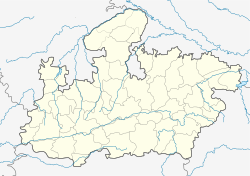Sanchi Town
| Sanchi Town | |
|---|---|
| Nagar panchayat | |

Village Sanchi from the Sanchi hill
|
|
| Coordinates: 23°28′50″N 77°44′11″E / 23.480656°N 77.736300°ECoordinates: 23°28′50″N 77°44′11″E / 23.480656°N 77.736300°E | |
| Country | India |
| State | Madhya Pradesh |
| District | Raisen |
| Population (2001) | |
| • Total | 6,785 |
| Languages | |
| • Official | Hindi |
| Time zone | IST (UTC+5:30) |
Sanchi Town is a Nagar panchayat in Raisen District of the state of Madhya Pradesh, India, it is located 46 km north east of Bhopal, and 10 km from Besnagar and Vidisha in the central part of the state of Madhya Pradesh. Known for its "Sanchi Stupas", it is the location of several Buddhist monuments dating from the 3rd century BC to the 12th CE and is one of the important places of Buddhist pilgrimage.
In Mahavamsa the site is referred to as Chetiyagiri, which was visited by Mahinda and his mother Devi. Early votive inscription refer to the place as Kakanaya. In the Gupta period it was termed Kakanada-Bota, and Bots-Shri-Parvat in the 7th century. An adjacent village is still called Kanakheda.
The name Sanchi might have originated from Sanskrit and Pali word sanch meaning "to measure". In Hindi, however Sanchi or Sancha means "Moulds of Stones".
As of 2001[update] India census, Sanchi had a population of 6,785. Males constitute 53% of the population and females 47%. Sanchi has an average literacy rate of 67%, higher than the national average of 59.5%: male literacy is 75%, and to female literacy is 57%. In Sanchi, 16% of the population is under 6 years of age.
There are numerous monuments at Sanchi. The main are these, using the numbers assigned by Sir Alexander Cunningham, founder of the Archaeological Survey of India, who led excavations at Sanchi in 1854, which are still often used in the literature:
...
Wikipedia

